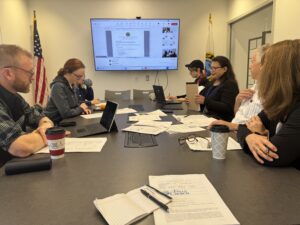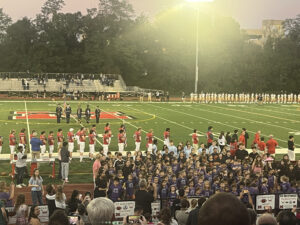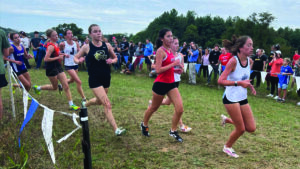After a 2006 spike in pedestrian deaths, Fairfax County has undertaken a massive effort to improve the county’s pedestrian-accessible infrastructure and instituted law enforcement campaigns in hopes the number of pedestrian related injuries and deaths will come down in 2007.
Last year Fairfax Country reported a total of 17 pedestrian fatalities, up from 10 in 2005. Reasons for the spike are not entirely known, according to Fairfax County Pedestrian Program Manager Chris Wells, but suspicions focus mainly on increasing numbers of immigrants without personal automobiles who are dependent on public transportation and walking as their main modes of transportation.
According to the Final Report of the Fairfax County Pedestrian Task Force issued in June of last year, the Board of Supervisors has been focusing on the issue of expanding pedestrian traffic since about 2001. The report states that while increased pedestrian traffic is “highly desirable,” the county had not foreseen this eventuality and had planned more carefully for increased automobile and truck traffic rather than foot and bicycle traffic. The mingling of the two has at times yielded fatal results.
Following the recommendations of the task force laid out in the report, the county has approved a sweeping 10-year, $60 million “pedestrian improvement plan” that will encompass the entire county. The plan includes sidewalk improvements, pedestrian bridges, bus stop upgrades, additional signage and lighting at crosswalks and public education on the subject of pedestrian safety.
One area of particular local concern is the Route 50 and Patrick Henry Drive intersection near Seven Corners which, according to a Fairfax County press release, is responsible for 25 percent of the pedestrian fatalities in the county and over half of the pedestrian crashes in the Mason District area. So far in 2007, the stretch has been the site of three fatal accidents.
The six-lane Route 50 (also known as Arlington Boulevard) is lined on both sides by retail developments, including the Seven Corners Shopping Center and the Wilston Shopping Plaza, and dense residential properties. Rather than utilize the crosswalk near Patrick Henry, pedestrians often take a more direct path, braving the wide span of roadway where vehicles often exceed the posted speed limit of 45 miles per hour. While researching the story, News-Press reporters witnessed upwards of 10 pedestrians crossing the strip over roughly a two-hour span. Those that are crossing the street have sometimes included mothers with strollers and small children.
Those that spoke with the News-Press sited the “inconvenience” of marked crosswalk at Patrick Henry as one of the primary motivators for their more direct dash across traffic.
“I do this all the time,” said Maurio Gomez through a translator. Gomez, a resident of the Seven Corners area, was observed crossing Arlington Boulevard near Seven Corners illegally. Many residents hold this same mentality, owing to the fact that utilizing the crosswalk could add some 400 yards to a route across Route 50 from one shopping plaza to another.
According to Mason District Supervisor Penny Gross, this intersection has been a concern since 1987, but only in the last two years have plans gotten underway to make the necessary improvements. Chief among the improvements to the corridor will be a $5 million pedestrian bridge, stretching from the Seven Corners Shopping Center to the Wilston Shopping Center across Route 50. The bridge will be combined with a length of fencing along Route 50 to discourage illegal, mid-block crossings.
Negotiations with business and land owners near the site, though somewhat drawn out due to easement issues with the county, have also produced plans for a future transit center to replace the bus shelters currently in place. In the end, after 20 years of delays and legal wrangling, Gross said “it’s finally going to get done.”
“We hope that [the bridge] will reduce pedestrian and auto interactions by up to 75 percent in the area,” she added.
The bridge and related projects are scheduled to break ground in November of this year.
While the many improvements are going on, Fairfax County is also attempting to address the changing demographics in the area — most notably the prevalence of non-English speakers. Some employees at businesses near the Route 50-Patrick Henry intersection believe there is a direct correlation between recent immigration trends and the increase in pedestrian accidents.
“We know who we’re talking about here,” said Doug, an employee at the Seven Corners Shopping Center Starbucks, who would not give his last name. “We need to work on people getting educated in their own language.”
A 2005 study by Inova Health Systems found that a disproportionate number of victims of pedestrian related accidents and fatalities were of Hispanic ethnicity, immigrants and often poor. These inhabitants tend to live centered around commercial developments for convenience sake, but the probability of a harmful or fatal incident is much higher in some of these areas, like the Route 50 and Patrick Henry Drive intersection.
To combat this, the Fairfax County Police Department has patrolled problem areas and handed out citations and educational literature (in English, Spanish and Arabic) to motorists and pedestrians regarding laws and regulations. However, there has not been a campaign at Arlington Blvd. and Patrick Henry since October of 2006 despite the high number of incidents.
The National Capital Region as a whole has also taken note of the importance of improving pedestrian safety, and plans to spend over $530 million through the NCR Transportation Planning Board in upcoming years to add sidewalks and bike lanes, and to make infrastructure accessible to the handicapped.
However, for all the effort, alterations and education, neither the government nor the police can control a person’s will.
“When you work all day, you only have a couple of hours to run errands. People want to get to the shops and stores along that corridor, and they tend to not want to walk an extra 100 yards to a crosswalk,” says Fairfax County Pedestrian Program Manager Chris Wells. “If a person is determined to cross, they will still be able to. But the changes and modernizations will certainly help.”












